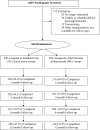Tobacco cessation among low-income smokers: motivational enhancement and nicotine patch treatment
- PMID: 24174612
- PMCID: PMC3954421
- DOI: 10.1093/ntr/ntt166
Tobacco cessation among low-income smokers: motivational enhancement and nicotine patch treatment
Abstract
Introduction: Despite decades of tobacco use decline among the general population in the United States, tobacco use among low-income populations continues to be a major public health concern. Smoking rates are higher among individuals with less than a high school education, those with no health insurance, and among individuals living below the federal poverty level. Despite these disparities, smoking cessation treatments for low-income populations have not been extensively tested. In the current study, the efficacy of 2 adjunctive smoking cessation interventions was evaluated among low-income smokers who were seen in a primary care setting.
Methods: A total of 846 participants were randomly assigned either to motivational enhancement treatment plus brief physician advice and 8 weeks of nicotine replacement therapy (NRT) or to standard care, which consisted of brief physician advice and 8 weeks of NRT. Tobacco smoking abstinence was at 1, 2, 6, and 12 months following baseline.
Results: The use of the nicotine patch, telephone counseling, and positive decisional balance were predictive of increased abstinence rates, and elevated stress levels and temptation to smoke in both social/habit and negative affect situations decreased abstinence rates across time. Analyses showed intervention effects on smoking temptations, length of patch use, and number of telephone contacts. Direct intervention effects on abstinence rates were not significant, after adjusting for model predictors and selection bias due to perirandomization attrition.
Conclusions: Integrating therapeutic approaches that promote use of and adherence to medications for quitting smoking and that target stress management and reducing negative affect may enhance smoking cessation among low-income smokers.
Figures
References
-
- Aveyard P., Begh R., Parsons A., West R. (2012). Brief opportunistic smoking cessation interventions: A systematic review and meta-analysis to compare advice to quit and offer of assistance. Addiction (Abingdon, England), 107, 1066–1073. 10.111/j/1360-0443.2011.03770.x - PubMed
-
- Baker A., Richmond R., Haile M., Lewin T. J., Carr V. J., Taylor R. L. … Wilhelm K. (2006). A randomized controlled trial of a smoking cessation intervention among people with a psychotic disorder. American Journal of Psychiatry, 163, 1934–1942. 10.117/appi.ajp.163.11.1934 - PubMed
-
- Becerra R., Shaw D. (1988). The Hispanic elderly: A research reference guide. New York: University Press
-
- Benjet C., Wagner F. A., Borges G. G., Medina-Mora M. E. (2004). The relationship of tobacco smoking with depressive symptomatology in the Third Mexican National Addictions Survey. Psychological Medicine, 34, 881–888. 10.1017/S0033291703001600 - PubMed
-
- Benowitz N. L., Bernert J. T., Caraballo R. S., Holiday D. B., Wang J. (2009). Optimal serum cotinine levels for distinguishing cigarette smokers and nonsmokers within different racial/ethnic groups in the United States between 1999 and 2004. American Journal of Epidemiology, 169, 236–248. 10.1093/aje/kwp215 - PubMed
Publication types
MeSH terms
Substances
Grants and funding
LinkOut - more resources
Full Text Sources
Other Literature Sources
Medical


